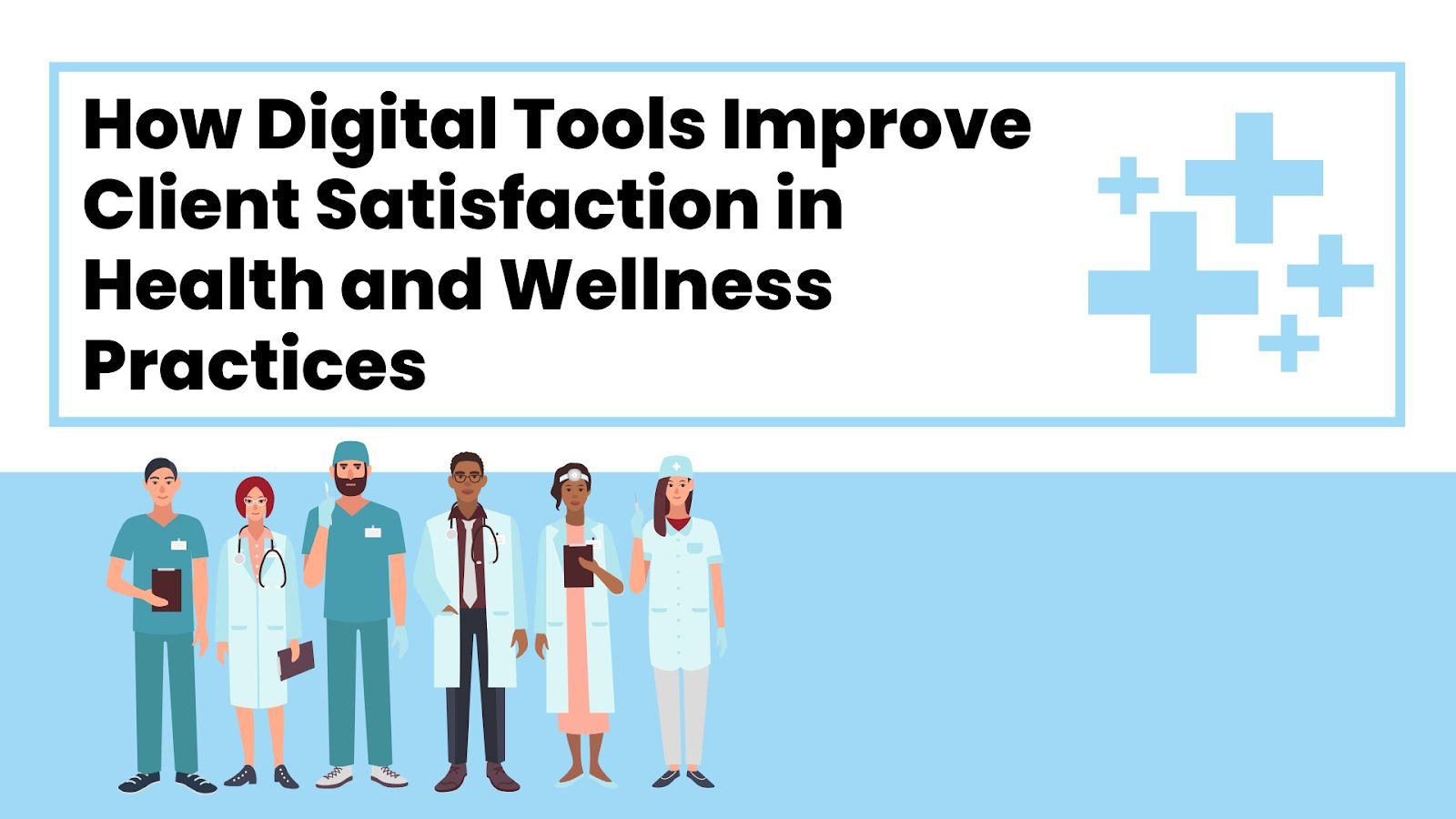Modern technology contains the power to change the game for health and wellness practitioners. These tools facilitate communication, customize service delivery, and enhance usability, leading to a better overall client experience.
Studies have shown that 84.9% of patients express satisfaction with telemedicine due to its convenience and ability to foster genuine, face-to-face interactions.
This blog post explores how various digital tools are reshaping client interactions in health and wellness, driving higher satisfaction and fostering stronger relationships between providers and clients.
Streamlining Communication Channels
Effective communication is the foundation of any successful client-provider relationship. Digital tools play a crucial role in facilitating seamless and timely interactions. Platforms like chatbots and instant messaging allow health and wellness practices to provide real-time support, addressing client queries and concerns with immediacy.
Case studies from health practices using these digital communication tools have reported improved response times, leading to higher client satisfaction ratings. Some organizations have even noted a significant reduction in appointment no-shows, further demonstrating the impact of efficient digital communication.
The integration of EHR systems has also streamlined communication by providing a centralized hub for client information and facilitating secure messaging between providers and clients. This enhanced coordination leads to a more cohesive and satisfying client experience.
Improving Personalized Client Experiences
Digital tools are very important for providing personalized services. About 87% of healthcare leaders say they are essential. Health and wellness practices can use data to better meet individual client needs. Key points include:
Collecting and Analyzing Data:
Practitioners gather and study client data.
This helps them understand clients better and create personalized experiences.
Custom Wellness Plans:
Tailored wellness plans boost client engagement.
Practices that use client data see better health results.
These practices also have more clients staying long-term.
Clients feel appreciated when their unique needs are met.
 By using technology and data, practices can build strong relationships with clients and improve their overall experience.
By using technology and data, practices can build strong relationships with clients and improve their overall experience.
Facilitating Access to Services
Digital tools greatly improve client satisfaction by making it easier to access health and wellness services. Online booking systems and telehealth options have changed how clients interact with their providers, offering more flexibility and convenience. Key points include:
Preference for Virtual Consultations:
About 55% of patients prefer virtual consultations over in-person visits.
Many enjoy the comfort of receiving care from home.
Impact of Telehealth on Satisfaction:
Telehealth significantly enhances client satisfaction.
Patients appreciate the flexibility and quick access to care.
Convenience of Virtual Visits:
Clients value the ease of scheduling virtual appointments.
These visits allow for immediate access to healthcare services.
Overall, easier access to services has led to more satisfied clients, as they no longer need to deal with travel and the inconvenience of in-person appointments.
Empowering Clients through Self-Service Tools
Self-service tools are a great way to boost client satisfaction. Client portals and mobile apps let clients manage their appointments, track their progress, and access health information on their own.
Increased Autonomy:
Clients using self-service tools feel more in control of their healthcare.
They report higher satisfaction levels.
Active Role in Healthcare:
These tools encourage clients to take an active part in their health journey.
This involvement improves client engagement.
Positive Client Feedback:
Many clients share that easy access to health information enhances their experience.
They appreciate being able to manage their care.
Improved Treatment Adherence:
Practices that use self-service technologies see better adherence to treatment plans.
Clients feel more involved and invested in their health.
Overall, empowering clients with self-service tools helps build stronger relationships between clients and healthcare providers, leading to a more satisfying experience.
Improving Through Client Feedback
Collecting client feedback is crucial for making improvements and boosting client satisfaction. Digital tools like online surveys and review platforms help healthcare practices gather valuable insights.
Identifying Areas for Improvement:
By asking for and analyzing client feedback, health and wellness practices can find out what needs to be improved.
This helps them make changes that address their client’s specific needs.
Adapting to Client Needs:
Practices that listen to client feedback often see increased satisfaction.
This shows the importance of the relationship between client input and service improvement.
Quick Response to Concerns:
Digital feedback tools allow healthcare providers to collect client insights easily.
These tools also help providers respond to client concerns quickly.
Building Trust and Satisfaction:
When providers are responsive to client feedback, it strengthens trust in the relationship.
This leads to higher client satisfaction overall.
By using client feedback effectively, healthcare practices can create better experiences and stronger connections with their clients.
Integration of Wellness Technology
The integration of wearable technology and health apps into health and wellness practices can significantly enhance client engagement and satisfaction.
These tools provide valuable insights into clients’ health metrics, allowing practitioners to offer more personalized care. Clients who use wearable devices and health-tracking apps often feel empowered and more involved in their well-being, leading to improved health outcomes and higher satisfaction levels.
Valuable Health Insights: Wearable devices provide important data on health metrics.
Empowerment: Clients feel more in control of their health management.
Informed Decision-Making: Real-time data helps practitioners make better decisions.
Positive Experiences: Successful practices using these technologies report enhanced client trust and satisfaction.
Building Community and Support Networks
Digital platforms can create a sense of community and support among clients. Social media groups, online forums, and interactive client portals allow clients to connect, share experiences, and encourage each other.
When clients feel a sense of belonging in their healthcare network, their overall satisfaction increases. Practices that build online communities report higher client engagement, reduced feelings of isolation, and better adherence to treatment plans.
Access to peer support empowers clients, making them feel valued and understood. This community-driven approach significantly enhances client satisfaction and promotes long-term well-being.
Increasing Client Satisfaction with Digital Solutions
Digitalization has a positive impact on the satisfaction of clients who seek health and wellness services. Such tools enhance focus on better interaction, customized services, and facilitation of access to the services, and therefore, clients’ satisfaction with the overall experience improves.
Clients have communication with instant feedback and get assistance that is relevant to their needs and desires. With the evolution of the health and wellness industry, there is a necessity for practices to implement such technologies. Not only does this strengthen the ties with the clients but also contributes to better health results.
Digital tools allow clients to take charge of their health, which increases their satisfaction. By using these tools, providers can exceed client expectations, creating trust and loyalty.
Embracing digital solutions helps practices stand out and ensures they meet client needs effectively. Overall, focusing on these advancements leads to a more satisfying experience for clients in health and wellness.
FAQs
What types of digital tools are most effective for improving client satisfaction in health and wellness practices?
Key digital tools that enhance client satisfaction include chatbots for real-time communication, online booking and telehealth platforms for accessibility, client portals for self-management, and wearable devices for personalized health tracking.
How can health and wellness practices ensure data privacy and security while using digital tools?
Health and wellness practices can ensure data privacy by implementing strong security measures, such as encryption and secure storage while complying with regulations like HIPAA and informing clients about data usage.
What metrics should health and wellness practices track to measure client satisfaction related to digital tool usage?
Practices should monitor key performance indicators (KPIs) including client retention rates, survey feedback scores, engagement metrics, appointment no-show rates, health outcomes, and Net Promoter Score (NPS) to gauge client satisfaction.
Brit is a passionate writer with a love for storytelling and exploring the depth of human experience through words. With a keen eye for detail and a thoughtful voice, Brit crafts pieces that resonate with readers and spark meaningful reflection. When not writing, Brit enjoys quiet moments with a good book, long walks, and finding inspiration in everyday life.






